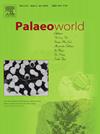南大西洋Cape盆地两个近海岩心白垩-古近系孢粉碎屑及其古环境意义
IF 1.7
3区 地球科学
Q2 PALEONTOLOGY
引用次数: 0
摘要
来自南非西部边缘的两个岩心孢粉碎屑为研究白垩纪/古近纪(K/Pg)界线的地层变化及其沉积环境提供了机会。在Cape盆地两个相距约243 km的海上钻孔中采集的200多个岩心和岩屑的孢粉碎屑变化趋势反映了白垩纪和早新生代的区域环境过程。鉴定并记录了孢粉和孢粉碎屑(植物碎屑)的13类显微结构。这些类别包括无定形有机物、海洋苔藓、淡水藻类、树脂、黑色碎片(木炭)、黄棕色碎片、黑棕色碎片(包括微观木炭)、角质层、植物组织、木质材料、孢子形和真菌材料,如真菌孢子、果体、管和细丝。分析比较了各地点有机组分的相对丰度。随着时间的推移,不同钻孔地点的孢粉碎屑组成和模式有所不同,但也显示出一些相似的区域趋势,例如,从晚白垩纪到早古新世,燃烧的迹象越来越多。木本成分表明,这两个海上遗址通过河流运输获得了相似的陆源白垩纪和新生代沉积物。将孢粉碎屑与先前发表的岩心孢粉学数据进行比较,显示出植被和气候的变化。在K/Pg边界附近和之后不久,黑色碎屑和黄棕色碎屑组分波动强烈,可能更多地与马斯特里赫特海退事件的过渡有关,而不是与K/Pg边界事件有关。在晚白垩世和古近纪期间,海相地貌的增加以及海绿石砂岩、头壳类、其他双壳类和壳壳类物质的地质证据表明,海相影响较强,反映了盆地的洪水。地层学和沉积环境有助于更好地了解与南大西洋开放有关的条件。本文章由计算机程序翻译,如有差异,请以英文原文为准。
Cretaceous–Paleogene palynodebris from two offshore cores in Cape Basin, South Atlantic Ocean and their paleoenvironmental implications
Palynodebris in two cores from the western South African margin provides an opportunity for investigating stratigraphical changes across the Cretaceous/Paleogene (K/Pg) boundary and the depositional environments during this interval. Changing palynodebris trends of more than 200 sidewall cores and cuttings, sampled from two offshore ocean borehole sites ca. 243 km apart and situated in the Cape Basin, reflect the regional environmental processes during the Cretaceous and early Cenozoic. Thirteen categories of microscopic structures of palynomorphs and palynodebris (phytoclasts) are identified and recorded. These categories include amorphous organic matter, marine palynomorphs, fresh-water algae, resins, black debris (charcoal), yellow-brown fragments, black-brown fragments (including microscopic charcoal), cuticles, plant tissues, woody material, sporomorphs, and fungal material such as fungal spores, fruit bodies, tubes and filaments. The relative abundances of these organic components from each site were analyzed and compared. Palynodebris compositions and patterns differ between borehole sites over time but also show some similar regional trends, e.g., growing indications of burning from the Late Cretaceous to early Paleocene. The woody component suggests that both offshore sites received similar land-derived Cretaceous and Cenozoic sediments via fluvial transport. Palynodebris was compared to previously published palynological data from the cores, showing shifts in vegetation and climate. Around and shortly after the K/Pg boundary, black debris and yellow-brown debris components fluctuate strongly and could possibly be related more to the transition from the Maastrichtian regressive events than a terminal K/Pg boundary event. Stronger marine influence, as indicated by an increase of marine palynomorphs together with geological evidence of glauconitic sandstone, Inoceramus, other bivalves, and shelly material during the Late Cretaceous and Paleogene, reflects the flooding of the basin. The stratigraphy and depositional environments contribute to a better understanding of conditions associated with the opening of the South Atlantic Ocean.
求助全文
通过发布文献求助,成功后即可免费获取论文全文。
去求助
来源期刊

Palaeoworld
PALEONTOLOGY-
CiteScore
4.00
自引率
5.90%
发文量
95
期刊介绍:
Palaeoworld is a peer-reviewed quarterly journal dedicated to the study of past life and its environment. We encourage submission of original manuscripts on all aspects of palaeontology and stratigraphy, comparisons of regional and global data in time and space, and results generated by interdisciplinary investigations in related fields. Some issues will be devoted entirely to a special theme whereas others will be composed of contributed articles. Palaeoworld is dedicated to serving a broad spectrum of geoscientists and palaeobiologists as well as serving as a resource for students in fields as diverse as palaeobiology, evolutionary biology, taxonomy and phylogeny, geobiology, historical geology, and palaeoenvironment.
Palaeoworld publishes original articles in the following areas:
•Phylogeny and taxonomic studies of all fossil groups
•Biostratigraphy, chemostratigraphy, chronostratigraphy
•Palaeoecology, palaeoenvironment and global changes throughout Earth history
•Tempo and mode of biological evolution
•Biological events in Earth history (e.g., extinctions, radiations)
•Ecosystem evolution
•Geobiology and molecular palaeobiology
•Palaeontological and stratigraphic methods
•Interdisciplinary studies focusing on fossils and strata
 求助内容:
求助内容: 应助结果提醒方式:
应助结果提醒方式:


